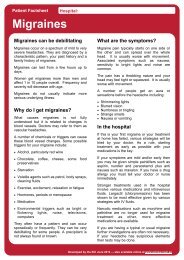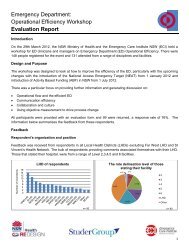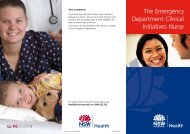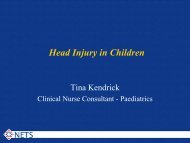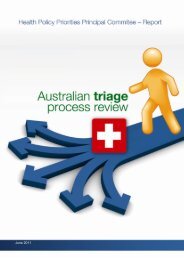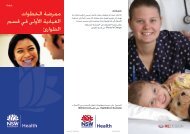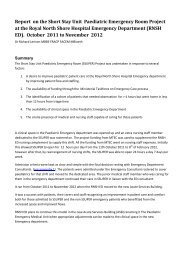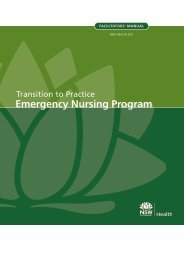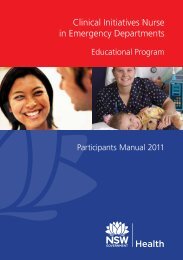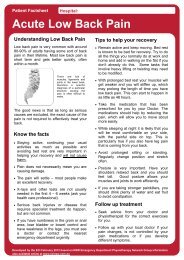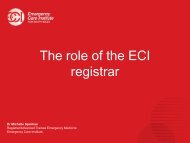Emergency Department Models of Care 2012 - NSW Health
Emergency Department Models of Care 2012 - NSW Health
Emergency Department Models of Care 2012 - NSW Health
- No tags were found...
Create successful ePaper yourself
Turn your PDF publications into a flip-book with our unique Google optimized e-Paper software.
SECTION 3<strong>Emergency</strong> <strong>Department</strong> <strong>Models</strong> <strong>of</strong> <strong>Care</strong>The following section describes all the <strong>Models</strong> <strong>of</strong> <strong>Care</strong> inthe ideal ED patient journey. It provides detailed informationabout the current ED models, developed to improve patientflow through the ED and explains how they work, thebenefits and challenges, the case for change andmonitoring measures for success.The <strong>Models</strong> <strong>of</strong> <strong>Care</strong> are relevant to all EDs that are levelthree and above. While they may not be applicable to EDswith no onsite medical staff, the principles are the same forall <strong>NSW</strong> EDs. These principles are that: EDs cater toemergency patients – patients who would be better servedby an alternative care provider should be referred directly tothat provider; the ED should not be used as an alternativewhen other services are unavailable; care should bestreamlined; and there should be no duplication <strong>of</strong>assessment and treatment.The information in each MOC will help the ED and hospitalto understand:■■■■■The key principles <strong>of</strong> the model.The key requirements to operate the model.Considerations to help understand why your ED woulduse the model.Benefits and challenges <strong>of</strong> using the model.The monitoring measures that can be used to assess themodel effectiveness and success.The following descriptions should be used as a guide tounderstand the potential options available to improvepatient flow and clinical outcomes in your ED. The modelsare set out in tables and provide the user with essentialinformation to determine if the model is suitable for yourED. The MOC tables include the following sections:■■What is the model? This section explains how the modelfunctions. Use this to determine if the characteristics <strong>of</strong>the model meet the needs <strong>of</strong> your ED to improvepatient flow and clinical outcomes.Why use the model? This section details the reasonswhy the ED would implement this model by highlightingkey areas <strong>of</strong> ED that the model can improve. Use thisinformation to determine if the model can assist yourED to improve patient flow and clinical outcomes.■■■■■■Key principles. This section explains in more detail theessential requirements <strong>of</strong> the model to functioneffectively. Without these principles in place thelikelihood <strong>of</strong> the model failing is high. Determine if yourED can successfully adhere to the principles. Also usethis section as a reference when determining businessrules, policies and processes for the model in your ED.Benefits <strong>of</strong> the model. This section reveals the expectedbenefits <strong>of</strong> the model and provides examples <strong>of</strong>potential improvements that you may expect if themodel is implemented correctly. Analyse your currentperformance data to determine if these benefits canimprove patient flow, clinical outcomes andperformance measures in your ED.Challenges. This section highlights key challenges thathave been experienced by others when implementingthe model. Use this as a guide when designing yourimplementation plan to mitigate potential issues thatmay arise.Case for implementation. This section includes questionsto support the need <strong>of</strong> the ED to implement the MOC.Use these questions as a reference to determine if thereis readiness in your ED to implement the model. Theycan also be used when designing your implementationplan or when assessing if your model has beenimplemented correctly.What you need to run the model. This section explainsthe essential requirements to run the model successfullyin your ED. This includes the physical space, staffing andbusiness rules <strong>of</strong> the model. It is important to use thissection as a reference when designing yourimplementation plan and when assessing if your modelhas been implemented correctly.Monitoring measures. This section outlines suggestedmonitoring measures that your hospital can use toevaluate the effectiveness <strong>of</strong> the model. Use thesemeasures when implementing or assessing anestablished MOC as they will help to determine theeffectiveness and highlight any weakness <strong>of</strong> the model.After considering each component <strong>of</strong> the model, your<strong>Emergency</strong> <strong>Department</strong> should have a clear understanding<strong>of</strong> how the model works, the potential benefits and<strong>Models</strong> <strong>of</strong> <strong>Emergency</strong> <strong>Care</strong> <strong>NSW</strong> HEALTH PAGE 9




